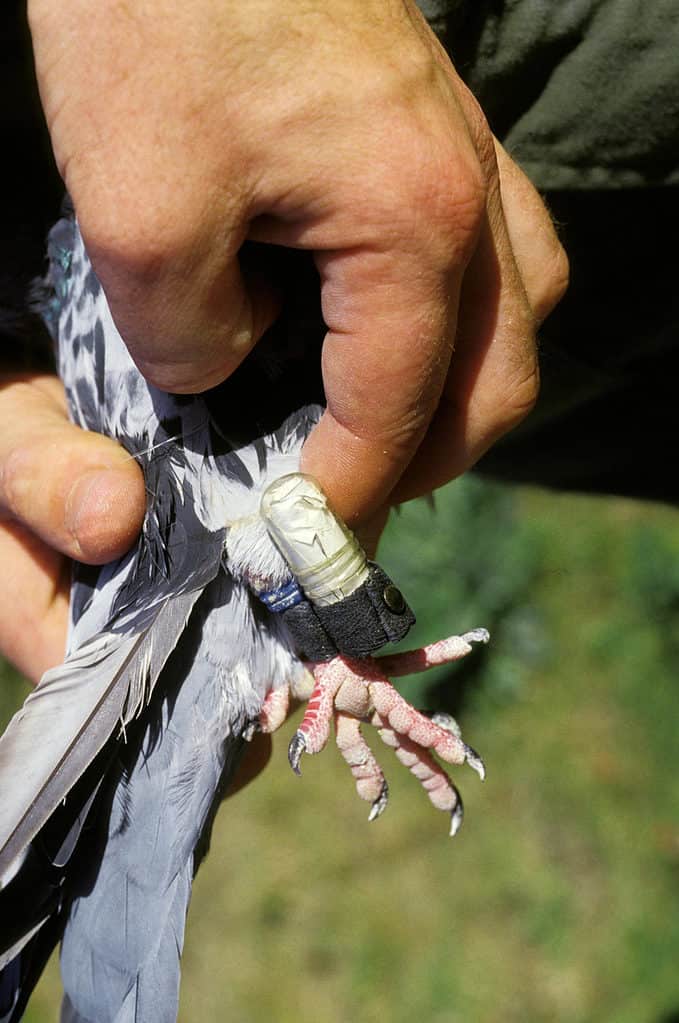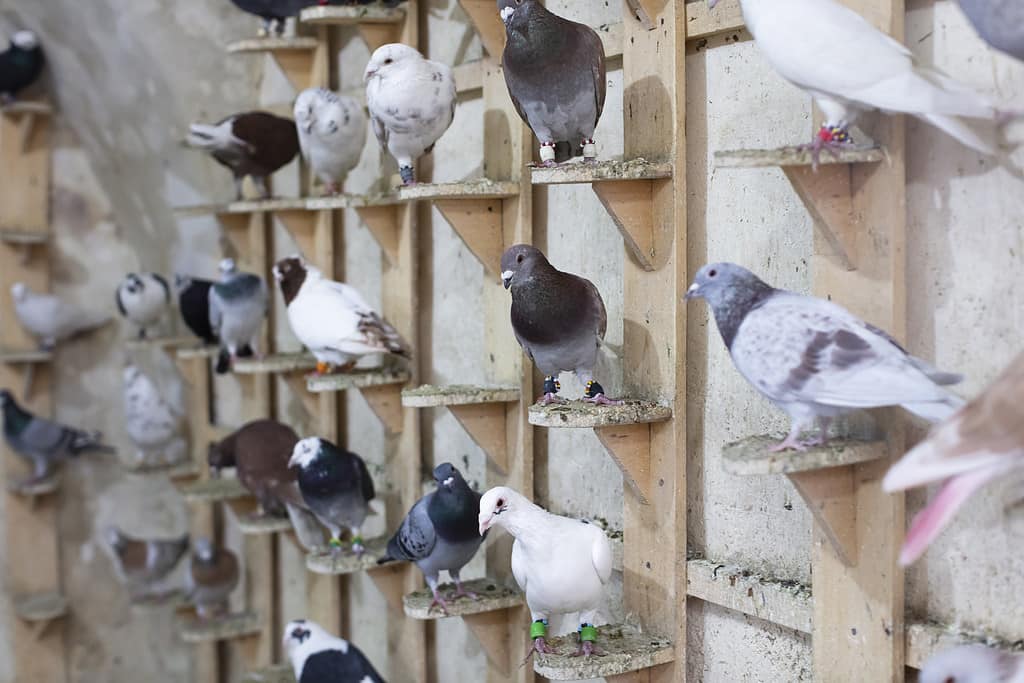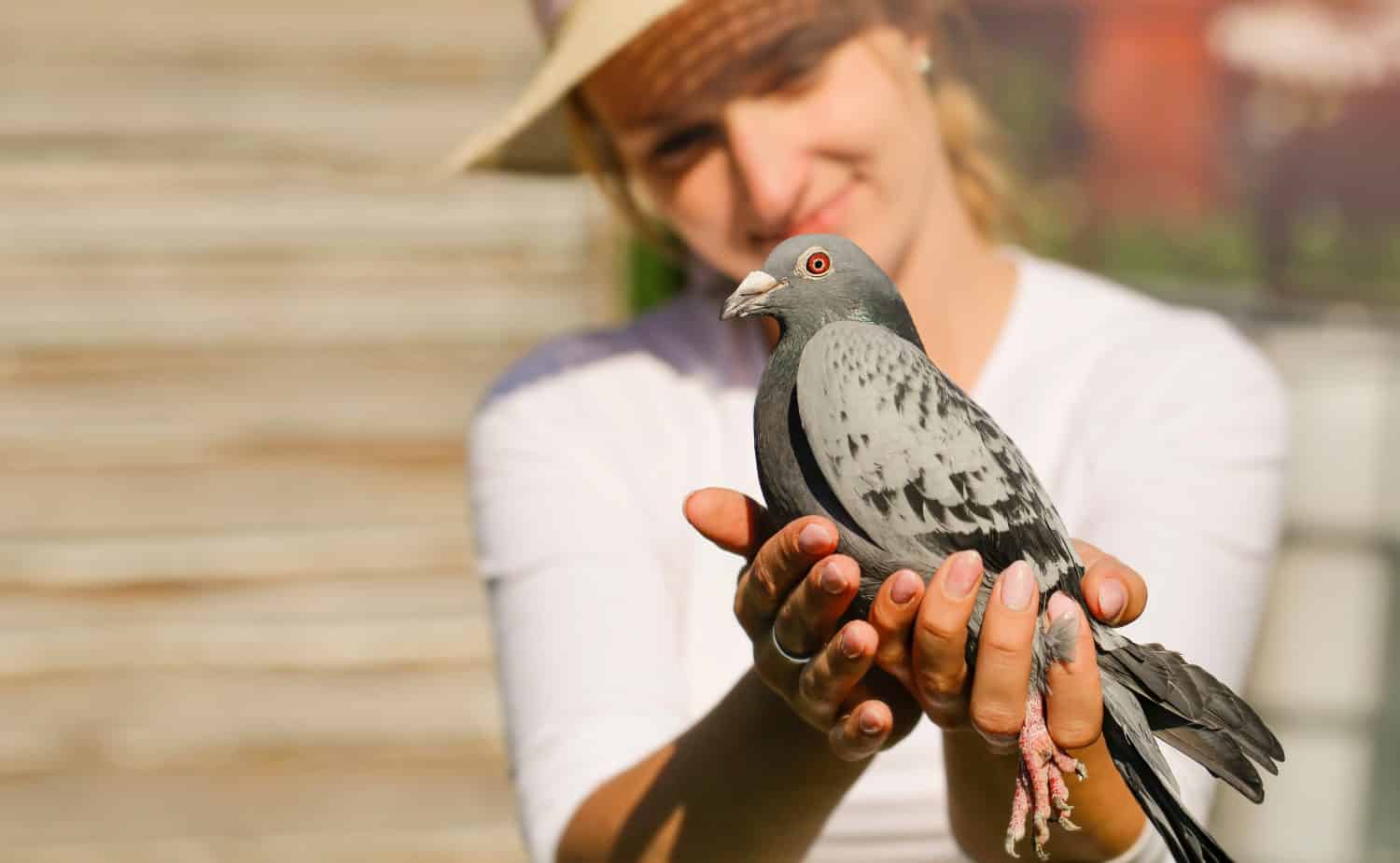In today’s modern world, communication is instantaneous. All you need to do is pick up a phone and immediately you can talk to someone on the other side of the world! But for most of history, communication was much more complex and time-consuming. Messages took several days, weeks, or even months to reach their destination. That’s why carrier pigeons were so revolutionary. They offered a reliable and surprisingly quick way to transmit important information under tight deadlines. These incredible birds not only made it easier to communicate, but their messages helped win wars and save thousands of lives!
What Is a Carrier Pigeon?

Pigeons are typically docile and easy to train with food.
©MNStudio/Shutterstock.com
Carrier pigeons (i.e. homing pigeons, mail pigeons, messenger pigeons, war pigeons, etc.) are a type of domesticated pigeon (Columba livia domestica). They originated from the selective breeding of domestic pigeons and wild rock doves (Columba livia) and were trained to travel to or from specific destinations with tiny messages tied to their legs.
The Pigeon Post

Pigeons carry messages in a capsule tied to one of their legs.
©iStock.com/slowmotiongli
Historians believe that pigeons were domesticated around ten thousand years ago. Ancient Mediterranean sailors used pigeons to help them orient their ships toward land. The ancient Egyptians and Persians used messenger pigeons to announce a new pharaoh or report flood levels. The ancient Greeks and Romans also utilized carrier pigeons during major events, like announcing the victors in the Olympic games. The emperor of China was regularly receiving messengers via pigeon by 500 BCE. The pigeon post messenger system created by Genghis Kahn and his grandson Kublai Khan spanned one-sixth of the entire world. Many countries still utilized messenger pigeons in an official capacity up through the early 2000s. Today, many hobbyists continue to breed and train carrier pigeons.
War Pigeons

When they aren’t delivering messages, carrier pigeons rest in dovecotes.
©Dreamer Company/iStock via Getty Images
Carrier pigeons played a monumental role in many historical wars. Hannibal utilized messenger pigeons during his siege of Rome, as did Julius Caesar during his military campaign in Gaul. During the Franco-Prussian Siege of Paris (1870 to 1871), carrier pigeons were the only way those trapped in the city could communicate with the outside world. Despite the technological boom during World War I and World War II (i.e. radios, radar, motorized vehicles, machine guns, etc.), carrier pigeons remained a vital asset to troops.
One of the most famous examples from World War I was a male carrier pigeon known as Cher Ami. On October 21, 1918, Major Charles White Whittlesey and hundreds of his men (now known as the “Lost Battalion”) were trapped behind enemy lines. The major sent several messenger pigeons out, but only Cher Ami successfully delivered his message. The pigeon flew across 25 miles of intense battle in just 25 minutes, sustaining multiple injuries that eventually led to his death. Although many of Whittlesey’s men perished in the fight, 194 soldiers were saved thanks to this little carrier pigeon.
Several war pigeons assisted troops during World War II as well. A pigeon named G.I. Joe prevented the destruction of the Italian village Calvi Vecchia by delivering a message to call off an American air raid. A messenger pigeon named Commando completed 90 successful delivery missions, while a pigeon named Paddy delivered vital information during the D-Day landings. An indomitable carrier pigeon named Mary of Exeter delivered her messages despite being attacked by German hawks, shot, receiving shrapnel in her neck, and losing a wing!
Why Pigeons?

Pigeons are incredibly intelligent birds.
©mmpixel91/Shutterstock.com
Even ancient civilizations could communicate using human messengers or couriers on horseback, but these were not always reliable. A human messenger — especially during wartime — could be delayed or injured. Many also struggled with keeping the message private and confidential, and they were often easy to bribe. Pigeons, on the other hand, were much more reliable.
Carrier pigeons have incredible navigational skills and are famous for finding their way home, even across far distances. This is in part due to magnetoreception. Pigeons have a magnetic detector in their eyes and beaks. Scientists believe this helps them to perceive the Earth’s magnetic field, much like a built-in compass. In addition, pigeon neurons allow them to understand the “language” of this magnetic field, revealing how strong it is and which way it is pointing.
Carrier pigeons have many other excellent senses they use to navigate, such as their sense of smell, keen eyesight, memory of landmarks, and perception of environmental cues. In addition, pigeons can hear “infrasounds” (low-frequency sounds), such as those produced by weather patterns or ocean waves. Although humans can’t hear these super low sounds, we still produce a great deal of them. Unfortunately, these sounds can also confuse and disorient pigeons as they try to find their way back home.
The photo featured at the top of this post is © mmpixel91/Shutterstock.com
Thank you for reading! Have some feedback for us? Contact the AZ Animals editorial team.







